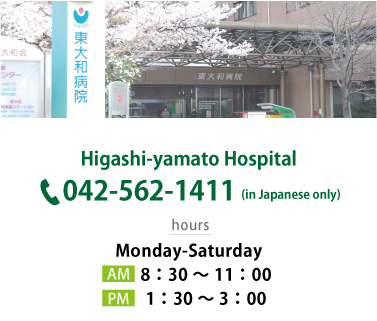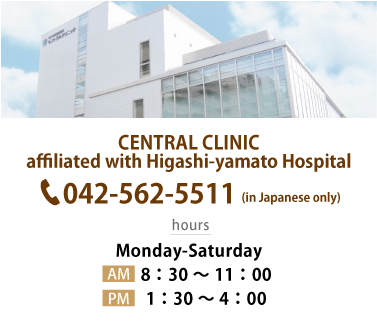
attention!
Our interpreter services may not always be available. Please make sure to bring a person with good conversational fluency in Japanese on your visit.
Sorry for your inconvenience.
Thoracic Surgery 胸外科
Our specialized area of expertise is thoracoscopic surgery (VATS), with a good name for lung segmentectomy and lobectomy.
There are five lung lobes, three on the right and two on the left. The standard method for treatment of lung cancer is lobectomy. However, with the increasing number of small-sized lung cancer, removing a large lobe is considered excessive in the case of a small lung tumor. With this point of view, partial resection may be a choice when the cancer is located near the surface of the lung. However, segmentectomy is the choice if it goes deep into the lungs.

The 5 lung lobes are further divided into 18 areas, and segmentectomy is the removal of these areas. This procedure had been usually difficult due to the complex involvement of vessels and bronchi, and an open chest approach had been chosen. The report of thoracoscopic segmentectomy was limited to only simple procedures. We pioneered the complex lung segmentectomy using an endoscope (thoracoscope) using 3D reconstruction of computed tomography (CT) to plan the operation and enabled even the most difficult operation via thoracoscopy.
Furthermore, each segment is divided into two or three sub-segments. Therefore, the lungs are divided into 42 subsegments. With further unique developments, we now adequately combine this subsegmental resection according to every patient's anatomy, so-called tailor-made surgery. So far, we've experienced more than 600 VATS segmentectomies at the previous hospital, and pioneering the new methods in this hospital. We had been invited to live surgeries, lectures, and so on in not only Asian but also European and North American countries as a pioneer in this field.

VATS is usually performed under general anesthesia by making a hole (port) between the ribs. In a multiple port approach, one 2 cm and two or three 5 mm ports are placed. We mainly use the single port approach at this hospital, and only one 3- to 4-cm hole is used. The merit of this approach is less pain. However, the quality of the inside maneuver is important, and complex surgeries may be difficult to perform via a single port. Adding a few thin 5-mm port may not cause a difference from the single port, so we discuss with the patient the best way to use both approaches according to individual anatomy.

So far, every patient who received an operation at the hospital has been discharged in good health. The chest tube was removed on the day of operation or the first postoperative day in 75% of thoracoscopically operated patients. The patient can drink, eat and walk on the evening of the day of surgery.
We'll be pleased if you choose our precise and accurate thoracoscopic lung operations.
微创胸外科是本院负有盛名的专科,尤其是胸腔镜(VATS)肺段/肺叶切除术。
人类有5个肺叶即右肺3个叶、左肺2个叶。肺癌以往的标准术式是肺叶切除术。然而,越来越多的早期微小肺癌能被筛查发现,若采取肺叶切除术的话,切除范围就显得过大。胸外科学术研究证实,如早期微小肺癌位于肺叶外周,楔形切除术就能够解决问题。但如果上述肺癌恰恰处于肺叶深部而非外周,此时楔形切除不可行,优选的手术方式就是肺段切除术。

人类的5个肺叶又可进一步划分为18个单位即18个肺段,肺段切除术就是针对这些单位而言。由于肺段的血管及支气管结构相当复杂,过去往往需要开胸才能完成肺段切除术。胸腔镜肺段切除术大多仅限于比较简单的肺段。我们率先利用计算机CT重建3D成像的技术,精准规划复杂肺段切除时的全部细节和步骤,甚至最困难部位的肺段切除也可以通过微创的胸腔镜来实现。
每个肺段又被进一步划分为2至3个亚段,因此肺实际上被分为42个亚段。经过我们前期的独创性实践,现在已能做到术前就对每个患者的解剖学特征进行个体化分析,得心应手地组合这些亚段并微创切除,正所谓“量体裁衣”版的精准手术。我们团队曾在大学附属医院顺利完成了600余例肺段切除术,现正在将这些尖端技术引进本院。作为该领域的先驱,团队多次受邀参加亚欧和北美地区的国际性学术演讲和手术直播。

VATS通常是全身麻醉下通过在肋骨之间“打孔”来实施。多操作孔时,需要作2cm切口再加2或3个5mm切口。而本院主要采取的则是单孔方式:即只作1个3-4cm的单切口。单孔方式最大的优势在于减轻术后疼痛。然而,胸腔内的解剖和分离才是最为重要的,单孔有时并不能精准完成某些高难度操作。这种情况下,可能需增加1个5mm的小切口。因此,根据手术复杂程度和个体解剖学差异,我们术前会与患者解释如何选择切口,尽管只是可能会增加一些个5mm切口这样的细节问题!

截至目前,在本院接受过上述手术的患者们均顺利出院、康复良好。75%的VATS手术当天或术后第1天就能够拔除胸管,这大大减轻了术后疼痛感。手术当晚患者就可以饮食和下地行走。
如您不幸罹患肺部疾病需要VATS肺切除,我们将以精湛的技术将不幸扭转为万幸!



